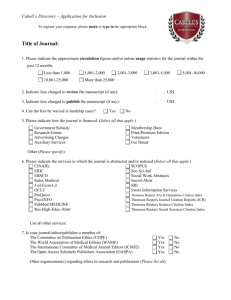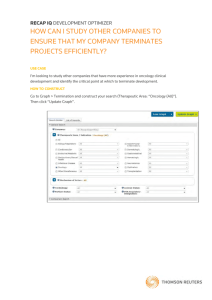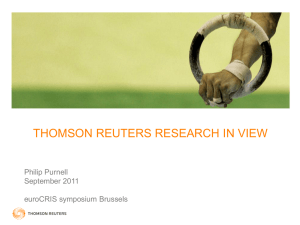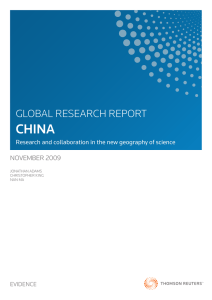INDIA GLOBAL RESEARCH REPORT OCTOBER 2009
advertisement
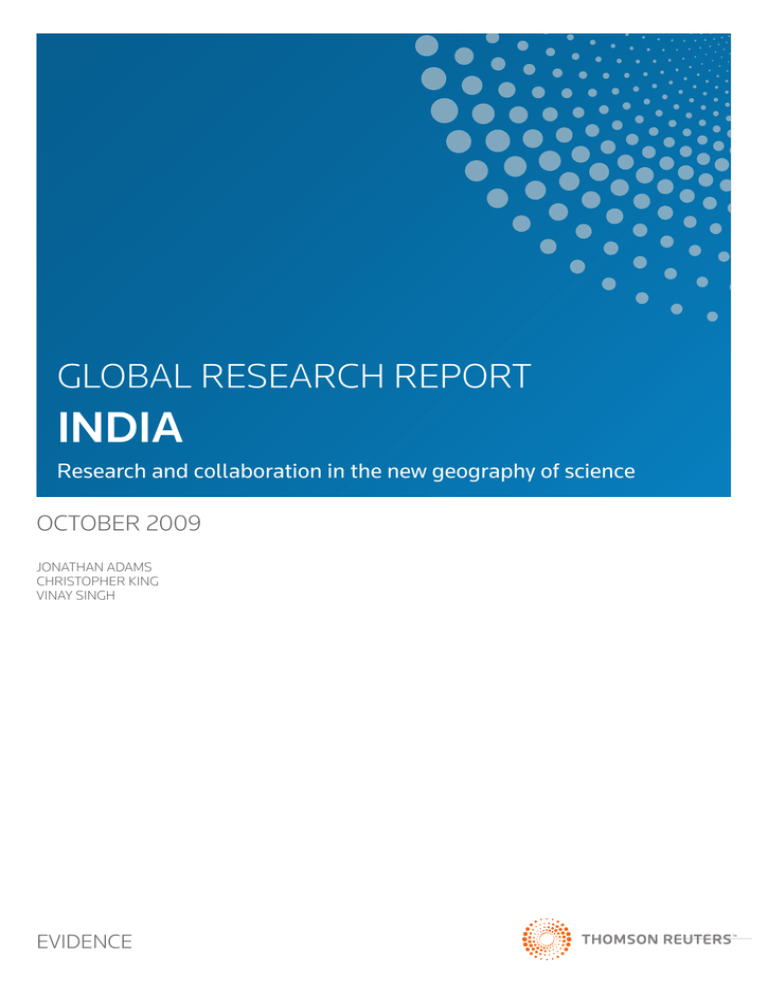
GLOBAL RESEARCH REPORT INDIA Research and collaboration in the new geography of science OCTOBER 2009 JONATHAN ADAMS CHRISTOPHER KING VINAY SINGH EVIDENCE THE AUTHORS Jonathan Adams is Director, Research Evaluation. He was a founding Director of Evidence Ltd, the UK specialist on research performance analysis and interpretation. Christopher King is Editor of Science Watch (ScienceWatch.com), a newsletter and web resource tracking trends and performance in basic research. Vinay Singh is National Manager of India, Healthcare & Science business of Thomson Reuters. He has over 14 years of extensive experience in the academic publishing and information industry. This report has been published by Evidence Ltd, a Thomson Reuters company 103 Clarendon Road, Leeds LS2 9DF, UK T/ +44 113 384 5680 F/ +44 113 384 5874 E/ enquiries@evidence.co.uk Copyright © 2009 Thomson Reuters ISBN: 1-904431-21-6 ....................................................................................................................... GLOBAL RESEARCH REPORT THE NEW GEOGRAPHY OF SCIENCE: RESEARCH AND COLLABORATION IN INDIA : OCTOBER 2009 INTRODUCTION This report is part of a series launched by Thomson Reuters to inform policymakers about the changing landscape and dynamics of the global research base. The previous Global Research Report examined Brazil and its growing presence on the world scientific stage. Here, we turn to another component nation in the so-called “BRIC” group: India, which, like Brazil and fellow BRIC members Russia and China, is building on its vast resources and potential in becoming a lead economic power. Underpinning the realization of that economic potential will be a significant expansion in its ability to generate and exploit its knowledge resources through research and the related skills of its workforce. The growth of knowledge and innovation capacity in the BRIC is already impacting on the global research system. The tradition of science in India, of course, extends back millennia, with Aryabhatta, Bhaskara, Brahmagupta, and others still celebrated for their foundational contributions to the fields of mathematics, astronomy, and chemistry. In the modern era, science and technology have been central to India’s development efforts since the nation achieved independence in 1947. Since then, via government directives such as the Scientific Policy Resolution (1958), the Technology Policy Statement (1983), and Science and Technology Policy (2003), the nation has achieved notable scientific successes. These include self-sufficiency in food grain production; a space program that has enabled satellite launches and a moon mission; an atomic energy program; indigenously developed missiles and aircraft; and exports in biotechnology, pharmaceuticals, and information-technology services. Despite these achievements, recent years have seen a growing realization among scholars, policymakers, and other observers that India lags behind other key countries and some of its BRIC partners in research investment and output. The government has made concerted efforts to invest in education by creating facilities such as the Indian Institutes of Science Education and Research, dedicated to the highest international standards of scientific research and science education. Funding for education and research has been a priority and has risen accordingly. The latest five-year plan, covering the years 2007 to 2012, includes a four-fold increase for education over the previous plan. Overall, as Nature reported earlier in 2009, government spending on science research currently accounts for roughly 0.9% of gross domestic product; by 2012, the figure is expected to rise to 1.2%. A nagging problem, however—perhaps paradoxically for the second-most populous nation on earth—is a current lack of human resources: the availability of qualified researchers has not kept pace with the increased funding. Government action has made progress in this regard. A report from India’s National Council of Applied Economic Research reported that the proportion of the population holding graduate degrees increased from 2.4% of the population (20.5 million) in 1991 to 4.5% (48.7 million) in 2005. Increase in government support of science, and the subsequent improvement of existing institutions or the establishment of new ones, is beginning to result in the return of expatriate researchers. Against this background of impressive achievement and ongoing challenges, we can assess India’s current place in world science. ....................................................................................................................... GLOBAL RESEARCH REPORT THE NEW GEOGRAPHY OF SCIENCE: RESEARCH AND COLLABORATION IN INDIA India’s recent increase is striking, rising sharply in contrast to the other nations’ largely static changes in growth since 2000. However, what many observers may note is the change in trajectory for India. References have been made in the science policy literature to India as a “sleeping giant.” DATA ON RESEARCH The data described in this report are drawn from the databases of Thomson Reuters, which regularly indexes data on articles in about 10,000 journals published worldwide. Numerous studies have confirmed that Thomson Reuters data-management policy ensures that its databases cover serials regarded by researchers as the most significant in their field. The Thomson Reuters data allow us to examine India’s particular areas of scientific concentration and strength, as well as the nation’s international links. International collaboration is an important marker of the significance of research activity to partners and of those other countries’ ability to engage with the domestic research base. Joint projects, and specific data on funding for joint research, are valuable information but tend to be collated inconsistently and incompletely. By contrast, joint publications are a sound and valid marker. Publication data are readily available, cover a wide range of countries, and can be grouped by year and subject. Every research paper includes the names and addresses of the authors. Thus, both the country of origin of authors and the association between co-authoring nations can be indexed and evaluated. ....................................................................................................................... GLOBAL RESEARCH REPORT INDIA AND RESEARCH PUBLICATIONS Growth in Papers Within the last decade or so, India has seen a substantial and recent growth in its annual output of scientific publications. Figure 1, covering 1998 to 2007, charts the increase in the number of Thomson Reutersindexed papers bearing at least one author address in India. From an essentially flat line between 1998 and 2000, the quantity of publication outputs begins rising steadily, increasing from roughly 16,500 papers in 1998 to nearly 30,000 in 2007. FIGURE 1 India’s research output has increased substantially since 1998 The rise is even more impressive given that, in 1981, India accounted for just above 14,000 papers in the Thomson Reuters database. The 2007 total constitutes an increase of roughly 80% in seven years from 2000. Nonetheless, the absolute volume for India is still only about half that for countries such as the UK, Germany, China or Japan. This is a surprise given the capacity of its economy. It has typically taken a 2.5%, now rising to 3%, share of world outputs. 30000 Annual publications in Web of Science 25000 20000 15000 1998 1999 2000 2001 2002 2003 2004 2005 2006 2007 FIGURE 2 150 India’s recent increase is striking, rising sharply in contrast to the other nations’ largely static changes in growth since 2000. However, what many observers may note is the change in trajectory for India. References have been made in the science policy literature to India as a “sleeping giant.” The reasons for that emerge in this analysis. Compared to other nations with a major research base it did indeed slumber—deeply through the 1980s and only starting to awaken in the 1990s. But its research capacity and experience are such that, once moved, it has caught up with other nations in a strikingly brief period. 100 If this trajectory continues then India’s productivity will be on a par with most G8 nations within 7-8 years and overtake them between 2015-2020. India’s recent year-by-year growth has begun to increase sharply compared to well-established European and Asian research nations in the G8 250 JAPAN FRANCE GERMANY Volume of publications compared to 1981=100 We can assess India’s increased output in another way, because the world literature indexed by Thomson Reuters databases is growing. We can index each country’s “relative growth” by setting the volume of publication output on Web of Science® for each of a set of nations at a standard “100” in 1981, and then work forwards. In Figure 2 we compare India to such well-established research nations as France, Germany, and the United Kingdom. The analysis charts each nation’s year-by-year rise over its respective starting point. WORLD 200 UK INDIA 1981 1986 1991 1996 2001 2006 ....................................................................................................................... GLOBAL RESEARCH REPORT Where is India focused? papers published in journals indexed by Thomson Reuters. Here we examine how that share panned out across different subject areas. Along with charting India’s increase in scientific output in the last decade, we must also examine its scientific focus and assess the ways in which its areas of concentration map to the rest of the world. These matters are important for those interested in how best to engage with India’s growing research base and to take advantage of the opportunities for innovation that they will surely create. India’s publications are analyzed here by Essential Science Indicators categories for two successive five-year periods. The top ten categories ranked by India’s share of world publications in 2004-2008 are shown. India’s strength—as a share of total world activity— proves to be diverse, with Chemistry predominant for the most recent five-year period. It is followed closely by Agricultural Sciences, but agriculture has fallen back relative to the earlier period while Pharmacology has expanded rapidly. In fact, India’s portfolio is markedly balanced between the life sciences and physical sciences. We looked at India from two different levels of focus: first, a broad overview across the twenty-two major areas in Thomson Reuters Essential Science IndicatorsSM; then, a more detailed examination of the 250 specific fields covered in the Web of Science. In a recent five-year period, India produced roughly 126,000 papers, constituting 2.75% of the world’s TABLE 1 India’s share of world publications on Thomson Reuters databases 1999-2003 2004-2008 Rank Count Share(%) Count Share(%) Share Growth Chemistry 21,206 4.42 33,504 5.71 1 10 Agricultural Sciences 4,303 5.91 5,634 5.65 2 17 Materials Science 6,960 4.08 11,126 4.81 3 9 Pharmacology & Toxicology 2,034 2.80 3,866 4.25 4 3 Plant & Animal Science 8,132 3.58 10,190 3.77 5 19 Physics 11,700 3.00 17,295 3.70 6 14 Engineering 8,101 2.69 14,103 3.57 7 5 Geosciences 2,839 2.64 4,266 3.13 8 13 Space Science 1,322 2.44 1,665 2.79 9 18 Microbiology 1,078 1.62 2,273 2.79 10 2 ....................................................................................................................... GLOBAL RESEARCH REPORT Most striking of all might be the figures in the right-hand column, which track each field’s growth, in terms of percent increase, between the 19992003 and 2004-2008 periods. Two life-sciences fields, Microbiology and Pharmacology & Toxicology, have accounted for notable growth, reflecting the relatively high expenditure of the drugs and pharmaceuticals industry which accounts for around 45% of India’s private sector R&D. It will likely also signal a new prominence for India in these fields. Computer Science, although not shown in the table, actually accounted for the highest increase between the two intervals, increasing by more than 100% — a testament to the nation’s acknowledged strength in information technology. This has reportedly not been a sector of significant industrial-technological R&D investment, but the effect of the sector on workforce skills and competency may be reflected in these figures. By tracking the numerous subfields covered in the Web of Science, we can fine-tune the analysis to examine more closely the specific fields in which India is concentrated. Here, India’s historical strength in agriculture is more clearly delineated, with Agricultural Engineering topping the list and three other agriculture-related fields present. Medical fields are also prominent, notably what might be considered the traditionally important field of Tropical Medicine, along with a more recent refinement, Integrative & Complementary Medicine. Two fields related to materials also embrace both traditional and reinvented industries (Textiles) and wholly different approaches to materials (Crystallography). TABLE 2 India’s share of world output in ten fields in Web of Science Share (% of world) Volume (papers 2004-08) Agricultural Engineering 11.21 800 Tropical Medicine 8.32 716 Organic Chemistry 8.29 7,834 Dairy & Animal Science 8.24 2,184 Multidisciplinary Agriculture 7.89 1,735 Crystallography 7.51 3,397 Integrative & Complementary Medicine 7.47 382 Textiles 6.76 400 Medicinal Chemistry 6.50 2,756 Agronomy 6.07 1,686 Field ....................................................................................................................... GLOBAL RESEARCH REPORT COLLABORATION WITH INDIA In an assessment of India’s top ten research partners over the last ten years, the USA stands apart in terms of its frequency of co-authorship with India-based institutions. However, the level of collaboration—as a fraction of national domestic output—is lower for India than it is for other emergent nations such as Brazil and much lower than for established G8 partnerships. India thus appears to have been less well connected to international networks than some other countries but it therefore also retains a significant capacity to expand its collaborative links. India’s partners, as the table indicates, have remained largely stable, although there are some discernible changes between the 1999-2003 and TABLE 3 India’s leading international research partners in the last decade Share (%) of India Total Papers collaborative with India 1999-2003 2004-2008 USA 6,725 USA 10,728 6.7 Germany 2,667 Germany 4,284 2.7 UK 2,137 UK 3,646 2.3 Japan 1,908 Japan 3,017 1.9 France 1,393 France 2,402 1.5 Canada 927 South Korea 2,074 1.3 Italy 822 China 1,665 1.0 China 674 Canada 1,590 .98 Australia 643 Australia 1,338 .83 Netherlands 563 Italy 1,309 .81 South Korea 558 Switzerland 1,067 .66 Taiwan 540 Taiwan 1,102 .63 Switzerland 493 Russia 940 .58 Russia 482 Netherlands 874 .54 ....................................................................................................................... GLOBAL RESEARCH REPORT 2004-2008 periods. While the Netherlands and Italy have slipped in their positions, South Korea has hugely increased its percentage of papers collaborative with India in what is generally a doubling in volume of Indian collaborative output with Asian partners. The exception to that is Japan, which already had a strong presence. Whether this signals the emergence of a clearer regional research network is perhaps too early to say but it is certainly an issue which other regions will want to watch. The diversity of India’s research ties is elaborated in Table 4, which presents a selection of international organizations that have made especially numerous collaborations with India institutions in the last five years. The list is not a complete reflection of just the top ten organizations, but has been selectively edited to give a more diverse flavor to the richness of India’s links. Even so, the relative sparsity of European partners—and the absence of UK institutions—will be a surprise to policy observers. TABLE 4 International organizations collaborating frequently with India Organization Country Number of co-authored papers University of Tokyo Japan 686 University of Texas USA 642 Tohoku University Japan 639 Centre National de la Recherche Scientifique France 534 Korea University South Korea 534 Chinese Academy of Sciences China 533 National Taiwan University Taiwan 466 National University of Singapore Singapore 429 University of Melbourne Australia 423 University of Amsterdam Netherlands 384 ....................................................................................................................... GLOBAL RESEARCH REPORT OVERVIEW India has a long and distinguished history as a country of learning, knowledge and innovation. India is a huge part of and a vital source of influence on the future global economy. In the recent past, however, it has failed to realize its undoubted potential as a home for world-class research. There are signs that there is now a change in trajectory that will bring India up to the level where it can begin to realize its potential, to the benefit of its own population and economy as well as contributing to global knowledge networks. During the 1980s and early 1990s the output of India’s research base was almost static while other countries grew rapidly, particularly other countries in Asia. China expanded with an intensity and drive that led it rapidly to overtake leading European countries in the volume of its research publications. India is just beginning on that gradient and has only now got back to the relative position it held thirty years ago. India’s research portfolio is grounded in traditional disciplines such as those related to agriculture, which is no bad thing with a huge population to feed, and tropical medicine, with an obvious domestic demand. But its research base needs diversity and that is beginning to appear in its emerging strength in, for example, pharmaceuticals and the now rapid growth in the still surprisingly small research base in computer sciences. With all its diversity and capacity it seems a surprise that India does not collaborate more, that there are not more partners treading the trail to work with key Indian institutions. The collaborative network does now seem to be expanding, and it is expanding eastwards towards other new and emerging research economies and not to the traditional trans-Atlantic research axis. This is, perhaps, one of the most intriguing outcomes of the analyses implemented for this report. It deserves further investigation. For the meantime, we suggest that it is important for G8 partners to look to invest in their relationship with India before the opportunity to engage in such links with a reinvigorated sub-continent is preempted by equally innovative regional neighbors. The possibility is that the new geography of research may see not just new leading nations but a change in regional balances. Europe and the USA will want to be partners, not just observers, of what happens. ....................................................................................................................... GLOBAL RESEARCH REPORT Science Head Offices Americas Philadelphia +1 800 336 4474 +1 215 386 0100 Europe, Middle East and Africa London +44 20 7433 4000 Asia Pacific Singapore Tokyo +65 6411 6888 +81 3 5218 6500 India New Delhi Bangalore +91 11 3044 6419 +91 80 2555 0333 For a complete office list visit: science.thomsonreuters.com/contact AG0908174 Copyright ©2009 Thomson Reuters
